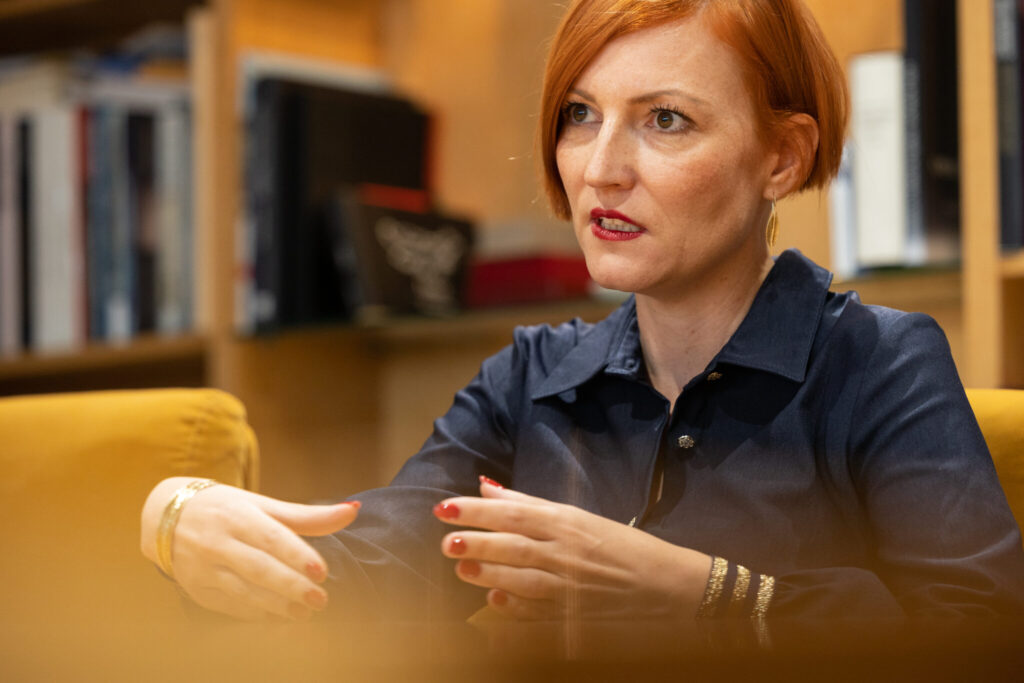Despite all its limitations, the apparatchik mind, which the Minister of Culture Asta Vrečko brings to Slovenian culture with gusto, zeal and true Comintern fervour, also has its own, so to speak, social-activist realisation. Since this is a broader social phenomenon, which the conduct of Minister Asta Vrečko brings into Slovenian life, we will call it the rise of the culturocrats.
Because of the conviction that this phenomenon is most apparent to us in the events surrounding Slovenia and Slovenian culture being the Guest of Honour at the Frankfurt Book Fair – the organisation of the former is led by the Slovenian Book Agency – we will focus, at least at the beginning of the illustration of this phenomenon, on two characters who play the main roles in this “honourable” feat: Katja Stergar, a former official at the Slovenian Book Agency, and Miha Kovač, an expert in the digitisation of our helpless gibberish.
But first, a few words about the phenomenon itself: who is a culturocrat? If we were to define this social role “developmentally” in relation to the current situation in Slovenian culture, we would say that the culturocrat represents the next stage of development from the level of the all-embracing bureaucratisation that every left-revolutionary regime first tries to stifle, and then to nip in the bud any social dynamic which, by its very existence unchecked, would put into question in a most delicate way the supposed total control over which both veteran Marxism and neo-Marxism or revivalism claim, at least declaratively, total exclusivity. The first condition for the emergence of the culturocrat, then, is the conception and then the construction of a cultural-artistic system. The beginnings of the Slovene one go back, of course, to the characteristically laid-back Yugoslav middle-class – not only in terms of mood but also the practice of the state-budget-subsidised artist and culturalist in the Socialist Federal Republic of Yugoslavia, which, among its many effects, created, among everything else, a new type of social man. It is a peculiar regime creation, which, partly due to the dominance of deep culture in post-independence Slovenia, and partly due to the inertia, and the non-existence, of the Slovenian cultural right, has stretched far into the present day. In the Titoist Yugoslavia or, to put it plainly, with slight retouchings in Dolanc’s Slovenia, too, under the conditions of totalitarianism, which was softening more and more, the following pattern was mainly established: an artist or a cultural activist, as a member of the middle class, was financially supported by the state on the condition that he or she refused to actively intervene in politics and to express views that would endanger the state order.
The pattern just illustrated has persisted, with some changes, to the present day: the cultural-artistic system has adapted to the somewhat softer totalitarianism that is the system of government in contemporary Slovenian democracy, and above all, its parastatal artery, now requiring the mediated and richly subsidised culturalist/artist to be a kind of simulacrum of social engagement: regardless of his or her convictions, the artist/culturalist, after receiving the subsidy, must engage in campaigns run from behind the scenes by the deep culture as an extended arm of the Slovenian parastate: in discrediting genuine dissidents, in orchestrating media pogroms, and in creating an atmosphere of obsession in the run-up to elections of one kind or another. We will discuss the psychological typology of the human being created by this kind of manipulation of human nature and national culture at another time – since it seems to me most appropriate at this point to focus on one of the key figures of the current Slovenian culturocracy, Katja Stergar, because even the most accurate portrayal of her personality will illustrate the typology of the Slovenian culturocrat as a tool for the suppression of even the faintest trace of cultural-artistic freedom by the Slovenian deep culture, led by Minister Asta Vrečko with awe-inspiring brigades-from-the-hills-esque jousting.
Katja Stergar embodies all the qualities of a distinctly continuity-oriented Slovenian culturocrat. Anyone who has ever dealt with her personally is well aware of her polit-commissariat communication, her tendency towards domination, her quite obvious conviction that the state institution is her property or the property of her political option; her education and her knowledge of the book only go so far, as they are defined by her worldview; she is a skilful institutional cadre, she immediately identifies a political opponent and tries to liquidate him or her behind the scenes, she is politically objective but characterless, which allows a deep culture to guide her actions. It is not surprising, then, that deep culture has chosen her as the executor of a project whose aim is to enclose its own position and exterminate any ideo-political or artistic-aesthetic opponents.
Source: www.kud-kdo.si


